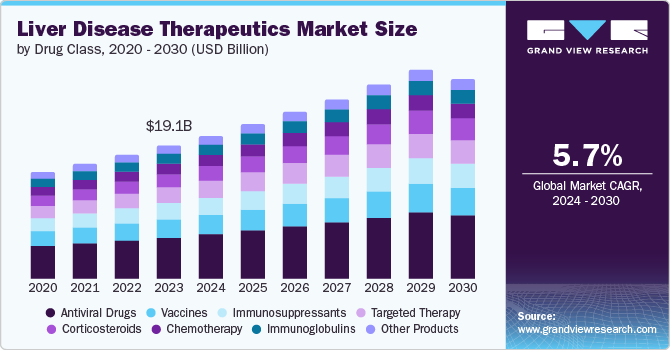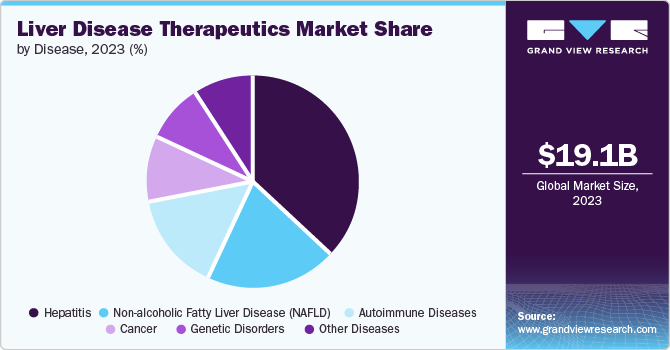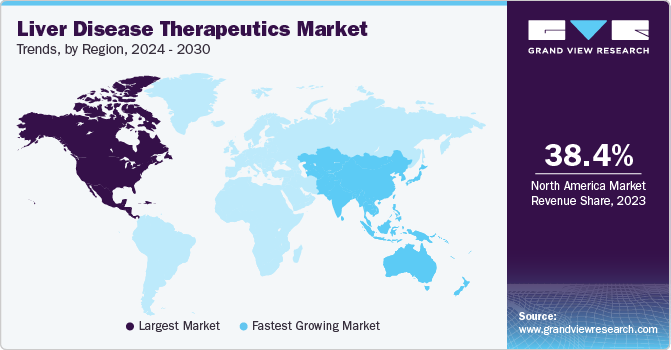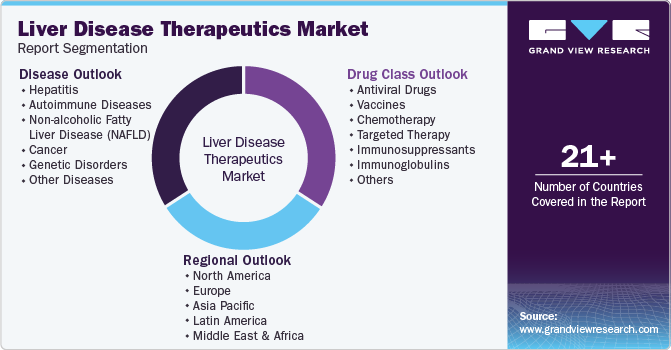- Home
- »
- Pharmaceuticals
- »
-
Liver Disease Therapeutics Market Size, Share Report, 2030GVR Report cover
![Liver Disease Therapeutics Market Size, Share & Trends Report]()
Liver Disease Therapeutics Market Size, Share & Trends Analysis Report By Drug Class (Antiviral Drugs, Vaccines), By Disease (Hepatitis, Autoimmune Diseases, Cancer), By Region, And Segment Forecasts, 2024 - 2030
- Report ID: 978-1-68038-540-3
- Number of Report Pages: 100
- Format: PDF, Horizon Databook
- Historical Range: 2018 - 2022
- Forecast Period: 2024 - 2030
- Industry: Healthcare
Liver Disease Therapeutics Market Trends
The global liver disease therapeutics market size was valued at USD 19.07 billion in 2023 and is projected to grow at a CAGR of 5.7% from 2024 to 2030. The rise in geriatric population, changes in lifestyle, excessive consumption of alcohol, increased funding by the government in research and development in innovation of the drug, rise in the prevalence of liver disorders and diseases such as nonalcoholic fatty liver, hepatitis, autoimmune diseases are the main factors driving the growth of the market. Furthermore, Increased awareness initiatives by the government and early liver disease diagnosis drive market growth.

The rising incidence of liver disease can be attributed to various factors, including unhealthy lifestyles, inadequate physical activity, and poor diet quality. According to the NCBI in 2023, liver disease is a significant global health concern, accounting for 4% of global deaths. The geriatric population is particularly vulnerable to liver diseases such as hepatitis, non-alcoholic fatty liver disease, and autoimmune disorders. Moreover, the growing number of patients with liver disease can also be linked to the increasing trend of alcohol consumption.
The growing demand for liver disease treatments has led healthcare organizations to invest in research and development of new medications, equipment, and treatment options. Biotechnology companies and research institutes have also provided significant funding for the development of new liver disease medications. This surge in investment is expected to lead to advancements and breakthroughs in the field, making the market more competitive and efficient.
As a result, the market for treating liver diseases is expected to grow, providing better opportunities for those involved. With the increasing number of patients seeking treatment, the market is poised to expand, driven by the need for effective and efficient treatments. The development of new medications and treatment options will likely contribute to the growth of the market, ultimately benefiting patients and healthcare providers alike.
Drug Class Insights
The antiviral drugs segment dominated the market in the global liver disease therapeutics market with a revenue share of 30.3% in 2023. The high incidence of hepatitis diseases contributes to the rise in liver disease cases. Antiviral drugs exhibit high reactivity in treating patients, with new developments leading to improved efficiency. The cost-effectiveness of these drugs is driven by the large patient pool of hepatitis and fatty liver patients. Strong demand for effective treatment fuels market growth.
The targeted therapy segment is expected to register the fastest CAGR of 7.2% over the forecast period, driven by the rising incidence of liver diseases and geriatric population globally. Targeted therapy offers personalized treatment options with minimal side effects, enabling patients to maintain a good quality of life. It also enables disease control, slows its progression, and improves patient condition.
Disease Insights
The hepatitis segment dominated the global liver disease therapeutics market with a revenue share of 36.6% in 2023. Segment growth is driven by the high prevalence of hepatitis A, B, and C, increased non-alcoholic fatty liver diseases due to excessive alcohol consumption and sedentary lifestyle, and growing demand for effective treatment. Untreated hepatitis can lead to liver cancer or failure, making awareness about its symptoms, such as loss of appetite and dark urine, crucial in driving segment growth.

Non-alcoholic fatty liver disease (NAFLD) is expected to register the fastest growth over the forecast period with a CAGR of 6.6%. Segment growth is fueled by the increasing prevalence of obesity and associated fat accumulation in liver cells. Obesity is a significant risk factor for NAFLD, and the growing population with obesity is expected to lead to a higher incidence of NAFLD. As there is no approved medication for NAFLD, weight loss and exercise remain the primary treatment options, contributing to the growth of this segment in the liver disease therapeutics market.
Regional Insights
North America liver disease therapeutics market dominated the global liver disease therapeutics market with a revenue share of 38.4% in 2023. Market growth is attributed to factors such as changes in lifestyle, and intense funding by the government and hospitals for the research and development of the disease. In addition, the rise in the consumption of alcohol, increasing weight, and increasing geriatric population play an important role in increasing the growth of the market.

U.S. Liver Disease Therapeutics Market Trends
The liver disease therapeutics market in the U.S. dominated the North America liver disease therapeutics market with a revenue share of 90.2% in 2023. This dominance is primarily attributed to lifestyle changes, including unhealthy diets, reduced physical activity, and heavy alcohol consumption, which have contributed to the increasing prevalence of liver diseases. This surge in liver diseases, combined with the emergence of novel treatments, has propelled the market’s expansion.
Europe Liver Disease Therapeutics Market Trends
Europe liver disease therapeutics market holds a significant market share in the global liver disease therapeutics market. Investment by the government and pharmaceuticals towards the research of innovative drugs leads the market growth. Moreover, rising awareness about liver disease and taking regular consultations are also driving the market growth. In addition, initiatives by the government for the patient to afford the treatment make patients early detection of liver diseases.
Liver disease therapeutics market in Germany held a substantial market share in 2023 owing to an increase in the funding by the government for innovation in liver disease treatment and due to more effective and innovative therapies people in Germany are up for early diagnosis for liver diseases driving the growth of the market.
The UK liver disease therapeutics market is expected to grow rapidly in the coming years. According to the British Society of Gastroenterology, 25% UK population is affected by NAFLD, this leads to an overall increase in the mortality rate and a rise in the risk of heart and liver diseases. Regulatory bodies such as MHRA and NICE ensure the safety, quality, and cost-effectiveness of liver disease treatments, while ongoing research and novel therapies position the country as a key player in the global market.
Asia Pacific Liver Disease Therapeutics Market Trends
Asia Pacific liver disease therapeutics market is expected to the fastest growth in the forecast period with a CAGR of 7.4%. This is due to a rise in research & development activities initiated by the government and pharmaceuticals, and unmet medical requirements. Moreover, people in the Asia Pacific region are following unhealthy diets and excessive consumption of alcohol. Hepatitis infection is on the rise in Asia Pacific region due to liver damage and fatty liver.
Liver disease therapeutics market in China has a significant market share in the liver disease therapeutics market. Strategic collaboration between pharmaceuticals has an impact on the growth of the market. In addition, rising geriatric population, unmet needs in liver cancer treatment, and growing investment in research and development driving the market growth
India liver disease therapeutics market is expected to grow in the forecast period due to increased focus on vaccination drives, rising geriatric population, government support for drug innovation, and rapid lifestyle change are driving the growth of the liver disease therapeutics market in India.
Key Liver Disease Therapeutics Company Insights
Some of the prominent companies in the liver disease therapeutics market include F. Hoffmann-La Roche Ltd; Takeda Pharmaceutical Company Limited; Gilead Sciences, Inc.; Johnson & Johnson Services, Inc. The market is marked by high entry barriers due to costly R&D and strict regulations. Players are investing in novel therapies through collaborations and acquisitions, driven by the growing prevalence of liver diseases and the need for effective treatments, fueling innovation and competition.
-
F. Hoffmann-La Roche Ltd focuses on innovative cancer treatments and diagnostics, Roche conducts extensive research to develop novel therapies and solutions for liver diseases such as viral hepatitis, non-alcoholic fatty liver disease, and liver cancer. Its portfolio includes approved drugs for liver disease treatment, and it continues to invest in pipeline candidates to address unmet medical needs.
-
Gilead Sciences, Inc. is known for its antiviral therapies for hepatitis B and C. The company’s portfolio includes approved drugs and it continues to invest in R&D to expand its pipeline. Gilead’s expertise in virology and commitment to addressing unmet needs have established it as a key player. Its global presence, financial resources, and innovation focus contribute to its position in the market.
Key Liver Disease Therapeutics Companies:
The following are the leading companies in the liver disease therapeutics market. These companies collectively hold the largest market share and dictate industry trends.
- Gilead Sciences, Inc.
- AbbVie Inc.
- Bristol-Myers Squibb Company
- F. Hoffmann-La Roche Ltd
- Takeda Pharmaceutical Company Limited
- Gilead Sciences, Inc.
- Johnson & Johnson Services, Inc.
- Merck & Co., Inc.
- Novartis AG
- Pfizer Inc.
- Sanofi
- AbbVie Inc.
- Bristol-Myers Squibb Company
- GlaxoSmithKline PLC
Recent Developments
-
In March 2024, Gilead Sciences acquired CymaBay, resulting in the potential for best-in-disease therapy for patients with primary biliary cholangitis. This acquisition allowed the company to conduct advanced research in liver diseases at that time.
-
In January 2024, Sanofi acquired Inhibrx, Inc., which increased the portfolio of medicine for the company. This acquisition aims for the company to add potential rare disease assets for Alpha-1 Antitrypsin Deficiency (AATD) assets to its portfolio.
Liver Disease Therapeutics Market Report Scope
Report Attribute
Details
Market size value in 2024
USD 20.55 billion
Revenue forecast in 2030
USD 28.62 billion
Growth rate
CAGR of 5.7% from 2024 to 2030
Base year for estimation
2023
Historical data
2018 - 2022
Forecast period
2024 - 2030
Quantitative units
Revenue in USD million/billion and CAGR from 2024 to 2030
Report coverage
Revenue forecast, company ranking, competitive landscape, growth factors, and trends
Segments covered
Drug class, disease, region
Regional scope
North America; Europe; Asia Pacific; Latin America; MEA
Country scope
U.S.; Canada; Mexico; Germany; UK; France; Italy; Spain; Denmark; Sweden; Norway; China; Japan; India; South Korea; Australia; Thailand; Brazil; Argentina; South Africa; South Arabia; UAE; Kuwait
Key companies profiled
F. Hoffmann-La Roche Ltd; Takeda Pharmaceutical Company Limited; Gilead Sciences, Inc.; Johnson & Johnson Services, Inc.; Merck & Co., Inc.; Novartis AG; Pfizer Inc.; Sanofi; AbbVie Inc.; Bristol-Myers Squibb Company; GlaxoSmithKline PLC
Customization scope
Free report customization (equivalent up to 8 analysts working days) with purchase. Addition or alteration to country, regional & segment scope.
Pricing and purchase options
Avail customized purchase options to meet your exact research needs. Explore purchase options
Global Liver Disease Therapeutics Market Report Segmentation
This report forecasts revenue growth at global, regional, and country levels and provides an analysis of the latest industry trends in each of the sub-segments from 2018 to 2030. For this study, Grand View Research has segmented the global liver disease therapeutics market report based on drug class, disease, and region:

-
Drug Class Outlook (Revenue, USD Million, 2018 - 2030)
-
Antiviral Drugs
-
Vaccines
-
Chemotherapy
-
Targeted Therapy
-
Immunosuppressants
-
Immunoglobulins
-
Corticosteroids
-
Other Products
-
-
Disease Outlook (Revenue, USD Million, 2018 - 2030)
-
Hepatitis
-
Autoimmune Diseases
-
Non-alcoholic Fatty Liver Disease (NAFLD)
-
Cancer
-
Genetic Disorders
-
Other Diseases
-
-
Regional Outlook (Revenue, USD Million, 2018 - 2030)
-
North America
-
U.S.
-
Canada
-
Mexico
-
-
Europe
-
UK
-
Germany
-
France
-
Italy
-
Spain
-
Denmark
-
Sweden
-
Norway
-
-
Asia Pacific
-
Japan
-
China
-
India
-
Australia
-
South Korea
-
Thailand
-
-
Latin America
-
Brazil
-
Argentina
-
-
Middle East & Africa
-
South Africa
-
Saudi Arabia
-
UAE
-
Kuwait
-
-
Share this report with your colleague or friend.
![gvr icn]()
NEED A CUSTOM REPORT?
We can customize every report - free of charge - including purchasing stand-alone sections or country-level reports, as well as offer affordable discounts for start-ups & universities. Contact us now
![Certified Icon]()
We are GDPR and CCPA compliant! Your transaction & personal information is safe and secure. For more details, please read our privacy policy.
We are committed towards customer satisfaction, and quality service.
"The quality of research they have done for us has been excellent."





